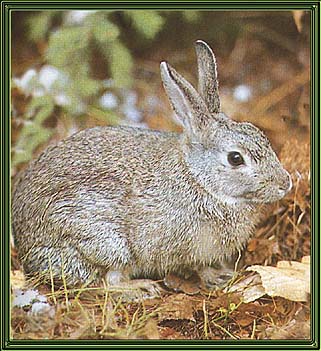
Oryctolagus cuniculus
Common Rabbit
In fact the name 'rabbit' was originally only applied to a young rabbit (see below), with an adult being called a 'cony' (above). The rabbit was introduced from France in the 12th century. The rabbit was protected for hundreds of years by landowners who valued it for its meat, and poaching was severely punished with even deportation....a "Botany Bay" job..ah..ah..Jim Lad...enough of that. It became the most familiar wild animal of the British countryside and also one of the most destructive agricultural pests
Biology:
Size and weight; The rabbit measures about 16 inches and weighs 3 - 4 lbs. When bread for meat, it can reach 15 lb.
Description: It has a black to buff coat, white belly and a short upturned tail. The female or doe is smaller and has a narrower head than the buck or male.
Life-Span: Rabbits in the wild rarely live longer than 12 months, there is a 90% mortality rate.
Reproduction: On average a doe will produce about 10 live young/year.
Gestation Period: Approximately four weeks.
Sexual Maturity: Three to four months.
Range: An adult rabbit will rarely venture firther than 200 metres from the main burrow, but juveniles can move up to 4 kilometres at the end of the breeding season.
Damage: This is estimated to run to £100 million per annum.
Food: Will eat 500 grams a day of green food, in other words they can eat up to 30% of their own weight in grass or crops.A social animal, the rabbit lives in colonies in warrens. It can live almost anywhere, from sea-level to the mountains, digging burrows on farmland, sand dunes, salt marshes, moorland, embankments and cliffs. Empty cliff burrows are often taken over by nesting puffins and shearwaters. The warren is dug in a haphazard way with interconnecting tunnels, bolt runs and emergency exits (bit of health and safety here I think). The burrows damage field boundaries and hedges, and disturb the surrounding soil, thus encouraging the growth of weeds such as nettles or ragwort. At breeding time the doe digs a seperate burrow called a stop, which she lines with hay, straw and fur from her own body. The stop may either be a 2 - 3 foot extension of the main warren or a completely seperate excavation which may eventually be the starting point of a new community.
Breeding may occur sporadically throughout the year but mainly between January to June going into August if the weather is good. A buck will mate with several does, but takes no part in the rearing of the young and may even kill them. Each doe keeps within her own territory in the warren. The popular notion of the rabbit's breeding capacity is not exaggerated, for it is possible for a doe to produce a litter of three to six young every month. However, this rarely happens, as over half of the young conceived die before they are born, and are reabsorbed back into the mother's body. As I said above the average production rate is about 10 live young per year.
The young rabbits are born below ground, deaf, blind and without fur. The doe visits her stop once a day to suckle the young and when she leaves she blocks the entrance to conserve heat and as a safeguard against enemies. Within a month the young are capable of looking after themselves. They reach adult size after about nine months but can breed after three or four months. A rabbit rarely lives more than a year and the mortality rate of the young is high. Among their enemies, apart from man, are cats, dogs, stoats, foxes, badgers, weasels, owls and buzzards. At dawn and at dusk rabbits emerge from the warren to feed. They establish clearly defined runways and communal toilets/latrines which are often on a mole-hill...a bit of a downer for the mole..! Rabbits do extensive damage to young trees by nibbling at the bark and eating the shoots, and also to cereals, roots and pasture land. The short turf on downland is the result of centuries of grazing by rabbits and sheep. Feeding is by refection, a similar method to chewing the cud as cows do, Food is eaten then excreted in a semi-digested form as soft moist pellets. These are then eaten again and passed through the intestine to be fully digested. It is the second dry pellets that are seen lying on the ground. The myxomatosis epidemic which began in 1954 in Britain almost wiped out the rabbit population of over 60 million, more than the human population at the time. The effects were noticeable on crops and vegetation, and predators, such as buzzards, declined. But the disease is no longer so leathal and the rabbit population is increasing again. Today, rabbits are controlled by gassing them in their warrens, ferreting, shooting and snaring. Tame rabbits also continue to flourish and in recent years the number of rabbit farms has increased.
© Stuart M Bennett 2001
